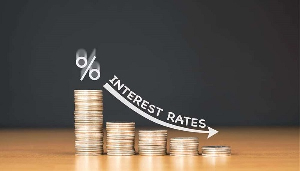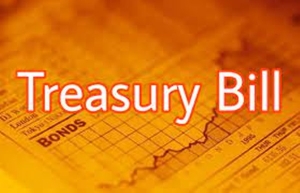- Home - News
- TWI News | TV
- Polls
- Cartoons
- Year In Review
- News Archive
- Crime & Punishment
- Politics
- Regional
- Editorial
- Health
- Ghanaians Abroad
- Tabloid
- Africa
- Religion
- Election 2020
- Coronavirus
- News Videos | TV
- Photo Archives
- News Headlines
- Press Release
- News Blogs
Business News of Friday, 23 August 2024
Source: Dr Maxwell Ampong, Contributor
A simple guide to understanding interest rates, policy rates, and bank rates in Ghana
The role of interest rates in shaping economic landscapes is deeply rooted in history. It has been influenced by evolving monetary policies, cultural beliefs, and responses to financial crises. By tracing this historical evolution, we can better understand the current role of rates and anticipate how they might adapt in the future.
Interest rates have varied considerably throughout history, responding to changing economic conditions, monetary policies, and financial crises. In ancient Mesopotamia, evidence suggests the existence of interest-bearing loans regulated by the Code of Hammurabi, indicating early recognition of the concept.
In Greece, philosophers like Aristotle debated the morality of charging interest, reflecting early ethical considerations. The Romans adopted and modified Mesopotamian practices, regulating interest rates while prohibiting usury and highlighting societal concerns about exploitation. Usury is the practice of lending money at unreasonably high rates of interest. I wonder if the Romans would speak up today, ha!
With the rise of Christianity in Europe, interest was strictly prohibited, leading to limited lending activity and economic growth. However, the medieval and Renaissance periods saw transformations with the emergence of merchant banking and the rise of banking houses, which circumvented usury laws and fuelled economic development.
The Industrial Revolution marked a surge in demand for capital investment, leading to the emergence of central banks and the development of financial markets and instruments.
In the 20th century, advancements in monetary policy saw central banks using interest rates to manage inflation, and the concept of a formal policy rate emerged during this period. The Great Depression highlighted the need for active monetary policy, leading central banks to target interest rates for managing economic activity. Following World War II, inflation targeting became prominent. Central banks set target inflation rates and used policy rates to maintain price stability.
The latter part of the 20th and 21st centuries witnessed further developments, such as increased communication about policy decisions, globalised policy coordination, and the rise of unconventional tools like quantitative easing alongside traditional policy rate adjustments. Understanding this history sheds light on the current role of policy rates and their potential future adaptations.
Throughout history, the concept of interest rates has evolved and been shaped by economic, cultural, and ethical considerations, highlighting its significance in the financial landscape. Early precursors include metal standards, where the money supply was linked to gold reserves and discount rates from central banks to commercial banks.
While central banks influencing economies has roots in ancient times, formal policy rates are a recent phenomenon.
What Are Policy Rates?
Policy rates are the interest rates set by the Bank of Ghana, which serve as the foundation for all other interest rates in the economy. When the Bank of Ghana adjusts the policy rate, it’s making a decision that affects borrowing costs, savings returns, and overall economic activity.
For instance, if inflation rises too quickly, the central bank might increase the policy rate to make borrowing more expensive. This discourages spending and helps cool down inflation. On the other hand, if the economy slows down, lowering the policy rate can make loans cheaper and encourage spending and investment.
In Ghana, the policy rate is a powerful tool the central bank uses to maintain economic stability. By tweaking this rate, the Bank of Ghana can influence the amount of money circulating in the economy, impacting everything from people’s spending to businesses’ investments.
What Are Bank Rates?
Bank rates are the interest rates that commercial banks charge their most creditworthy customers, often referred to as the prime rate or base rate. While the policy rate sets the stage, bank rates are what you, as a consumer or business, directly interact with.
When the Bank of Ghana adjusts its policy rate, commercial banks typically follow suit by adjusting their bank rates. If the policy rate goes up, banks might increase their lending rates to cover the higher borrowing costs from the central bank. Conversely, if the policy rate drops, banks might lower their rates to encourage more borrowing.
In Ghana, bank rates are crucial because they determine how much interest you’ll pay on loans or earn on deposits. Whether taking out a mortgage or a home loan, a business loan, or just saving money in a bank account, the bank rate affects your financial decisions.
How Interest Rates Fit In
The ‘interest rate’ is a more general term. It is simply the cost of borrowing money, typically expressed as a percentage. Interest rates apply to loans, mortgages, credit cards, and savings accounts. The interest rates that consumers and businesses encounter daily are influenced by both the policy rate and the bank rates.
For example, if you take out a loan, the interest rate determines how much extra you’ll pay over the life of that loan. Similarly, if you’re saving money, the interest rate tells you how much your money will grow over time.
Interest rates in Ghana can vary widely depending on the type of loan or savings product. Mortgage rates, for instance, might be lower than credit card rates because the risk to the bank is lower; the house is the collateral and is usually insured in more than a few ways. Business loans might fetch higher rates because of the inherent risk in running many businesses.
The Role of the Bank of Ghana
The Bank of Ghana plays a central role in managing the economy by adjusting the policy rate. This rate influences how much money is available and at what cost. During periods of high inflation, the Bank of Ghana might increase the policy rate to make borrowing more expensive, thereby reducing spending and cooling down the economy.
On the flip side, if the economy slows, the central bank might lower the policy rate to encourage borrowing and investment, stimulating economic activity. This balancing act is crucial for maintaining economic stability and growth.
The Evolution of Rates in Ghana
Historically, interest rates in Ghana, like elsewhere, have evolved in response to changing economic conditions. From ancient lending and borrowing practices to modern-day central banking, the concept of interest has always been linked to the broader economic environment.
In recent decades, the role of the Bank of Ghana has become more pronounced, particularly as the country’s economy has evolved. Introducing formal policy rates has allowed the central bank to take a more active role in managing the economy. For example, during times of economic crisis, the Bank of Ghana can adjust rates to help stabilise the economy.
How These Rates Affect the Broader Economy
Interest rates, driven by policy and bank rates, broadly impact the economy.
Influencing Borrowing and Spending: When the Bank of Ghana raises the policy rate, borrowing costs increase. This can reduce the demand for loans, slowing down consumer spending and business investments. Conversely, lower rates can encourage borrowing and stimulate economic activity.
Controlling Inflation: The Bank of Ghana can help control inflation by adjusting rates. Higher rates generally reduce spending, which can help lower inflation. Lower rates can have the opposite effect, potentially increasing inflation if the economy overheats.
Impacting Economic Growth: Lower interest rates can boost economic growth by making borrowing cheaper and encouraging investment. Conversely, higher rates can slow down development by making borrowing more expensive.
Maintaining Financial Stability: The Bank of Ghana uses policy rates to manage liquidity within the banking system, ensuring that banks have enough funds to meet their needs without causing excessive inflation or instability.
Practical Implications for Ghanaians
Understanding these rates can help you make better financial decisions.
Timing Your Loans: If you anticipate that rates might rise, lock in a loan when rates are low. Conversely, if rates are high, it might be wise to delay borrowing if possible.
Maximising Your Savings: By monitoring interest rates, you can choose the best savings accounts or fixed deposits to maximise your returns. For example, if rates are expected to rise, you may opt for shorter-term deposits to take advantage of higher rates later.
Investing Wisely: Interest rates also affect investment decisions. Rising rates might make bonds more attractive, while a lower-rate environment might favour equities or real estate investments.
The Future of Rates in Ghana
As Ghana’s economy continues to grow and evolve, the role of the Bank of Ghana and the influence of policy rates will likely become even more significant. The central bank’s decisions will continue to impact everything from the cost of borrowing to the returns on savings, making it essential for businesses and individuals to stay informed and adaptable.
Understanding interest, policy, and bank rates is crucial for navigating Ghana’s financial landscape. Whether you’re a business owner planning your next big investment or an individual looking to buy a home, these rates will play a key role in your financial decisions. By staying informed and understanding how these rates interact, you can make better decisions that align with your financial goals.
Ghana’s financial system is complex, but with a clear understanding of these fundamental concepts, you can navigate it with confidence and foresight. Whether the economy is booming or facing challenges, your knowledge of these rates will be a powerful tool in achieving financial success.
Entertainment










